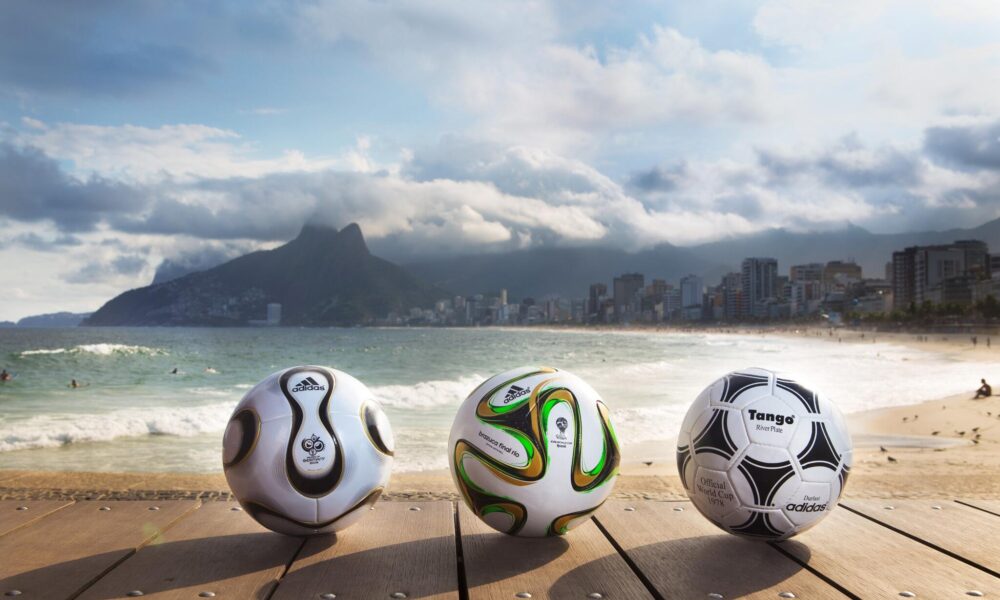Ever wondered which World Cup ball since the advent of the tournament back in Uruguay in 1930 is the most attractive and beautiful?
With the tournament set to commence in November, each country and players already have full knowledge about the team they would be playing once the tournament commences in Qatar.
Looking back on the history of the FIFA World Cup, which is, without doubt, the most followed international football competition that continues to provide the fans with unforgettable and iconic moments would once again take center stage this year.
The Adidas Innovation Team, partnering with the Molten Corporation, has produced every World Cup ball since England’s win in the 1966 World Cup, the last to feature the traditional brown leather.
So as we prep up for the World Cup in Qatar, we’re looking at some cracking and beautiful World Cup balls that are set to be used during the tournament.
Taking A Look At 5 Most-Alluring World Cup Balls
Telstar 18 – (Russia, 2018)

In November 2017 ahead of the World Cup, Adidas released the Telstar 18 which was the official match ball of the 2018 World Cup in Russia and was a recreation of the first Adidas ball used at the World Cup in 1970.
The colour on the Telstar 18 was the gold Adidas, while the logos printed on the white surface of the ball with the black sections gave a gradient and mosaic effect on the ball.
Like the Brazuca, the Telstar 18 had just six panels but they were arranged in an entirely new shape which made the visual effect to be more like the 32 panels of the 1970 ball.
Brazuca – (Brazil, 2014)

Brazuca is a Brazilian slang that according to FIFA describes national pride in the Brazilian way of life, and the ball itself was made to feature multi-colored ribbons that mimic popular Brazilian wish bands.
After the ball was made it was sent around the world to players, teams, and national associations for extensive testing, and the feedback received before the tournament was better than that of the Jabulani.
Even after the tournament in Brazil the Brazuca was adopted by a number of club leagues including the Major League Soccer and Bundesliga, and the most important thing is it’s attracted much less controversy unlike the Jabulani in South Africa.
Jabulani – (South Africa, 2010)

The Jabulani might be one of the most notorious balls ever made by Adidas due to the rounder than ever by decreasing in number from 14 to eight and its unpredictable movement, however, it’s one of the most beautiful official World Cup balls ever made by Adidas.
Top goalkeepers before the World Cup especially former Inter Milan goalie Julio Cesar compared the Jabulani to the cheap balls sold in supermarkets due to its unpredictability movement in the air.
However, the Jabulani ball was viewed as a beauty to behold due to its aesthetics but it was criticized due to how it affects passing as well as shooting.
READ ALSO | 10 Of The Most Iconic Nicknames In Football
Fevernova – (Korea/Japan, 2002)

The 2002 World Cup in South Korea and Japan began the era of an experiment for Adidas in terms of designing balls for the biggest FIFA football tournament.
With the Fevernova designed as the official ball for the World Cup in 2002, Adidas decided to ditch the traditional Tango look for a blank ball that was given larger green, gold, and red triangular patterns.
The Fevernova was tested and satisfied good to go by great players like David Beckham and Buffon, having been improved upon from its technical aspects and weight limit imposed by FIFA.
Al Rihla – (Qatar, 2022)

Ahead of the World Cup in Qatar Adidas released the official match ball for the tournament a few weeks ago and named it ‘Al Rihla’ which means the journey in Arabic.
The design of the ball differs somewhat from the previous World Cup balls, with 20 panels used while the speed and accuracy remain core principles for the manufacturers with Al Rihla built to maintain high flight speeds when playing around on the pitch.
According to Adidas, with a CRT core and textured speed-shell skin, it is believed the manufacturer has sought to ensure the ball suits the needs of an increasingly fast-paced game.
The Evolution Of World Cup Balls



